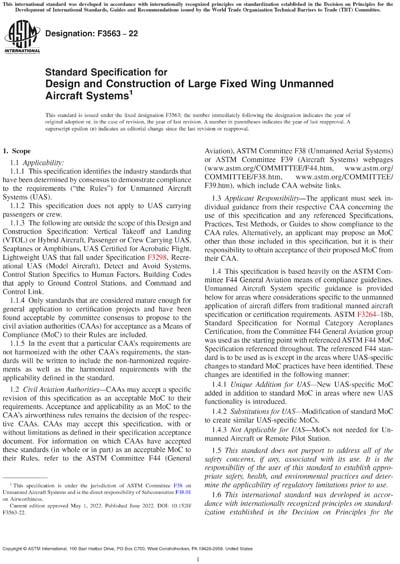Most recent
ASTM F3563-22
Standard Specification for Design and Construction of Large Fixed Wing Unmanned Aircraft Systems
1.1Applicability:
1.1.1This specification identifies the industry standards that have been determined by consensus to demonstrate compliance to the requirements ("the Rules") for Unmanned Aircraft Systems (UAS).
1.1.2This specification does not apply to UAS carrying passengers or crew.
1.1.3The following are outside the scope of this Design and Construction Specification: Vertical Takeoff and Landing (VTOL) or Hybrid Aircraft, Passenger or Crew Carrying UAS, Seaplanes or Amphibians, UAS Certified for Acrobatic Flight, Lightweight UAS that fall under Specification F3298, Recreational UAS (Model Aircraft), Detect and Avoid Systems, Control Station Specifics to Human Factors, Building Codes that apply to Ground Control Stations, and Command and Control Link.
1.1.4Only standards that are considered mature enough for general application to certification projects and have been found acceptable by committee consensus to propose to the civil aviation authorities (CAAs) for acceptance as a Means of Compliance (MoC) to their Rules are included.
1.1.5In the event that a particular CAA's requirements are not harmonized with the other CAA's requirements, the standards will be written to include the non-harmonized requirements as well as the harmonized requirements with the applicability defined in the standard.
1.2Civil Aviation Authorities - CAAs may accept a specific revision of this specification as an acceptable MoC to their requirements. Acceptance and applicability as an MoC to the CAA's airworthiness rules remains the decision of the respective CAAs. CAAs may accept this specification, with or without limitations as defined in their specification acceptance document. For information on which CAAs have accepted these standards (in whole or in part) as an acceptable MoC to their Rules, refer to the ASTM Committee F44 (General Aviation), ASTM Committee F38 (Unmanned Aerial Systems) or ASTM Committee F39 (Aircraft Systems) webpages (www.astm.org/COMMITTEE/F44.htm, www.astm.org/COMMITTEE/F38.htm, www.astm.org/COMMITTEE/F39.htm), which include CAA website links.
1.3Applicant Responsibility - The applicant must seek individual guidance from their respective CAA concerning the use of this specification and any referenced Specifications, Practices, Test Methods, or Guides to show compliance to the CAA rules. Alternatively, an applicant may propose an MoC other than those included in this specification, but it is their responsibility to obtain acceptance of their proposed MoC from their CAA.
1.4This specification is based heavily on the ASTM Committee F44 General Aviation means of compliance guidelines. Unmanned Aircraft System specific guidance is provided below for areas where considerations specific to the unmanned application of aircraft differs from traditional manned aircraft specification or certification requirements. ASTM F3264"“18b, Standard Specification for Normal Category Aeroplanes Certification, from the Committee F44 General Aviation group was used as the starting point with referenced ASTM F44 MoC Specification referenced throughout. The referenced F44 standard is to be used as is except in the areas where UAS-specific changes to standard MoC practices have been identified. These changes are identified in the following manner:
1.4.1Unique Addition for UAS - New UAS-specific MoC added in addition to standard MoC in areas where new UAS functionality is introduced.
1.4.2Substitutions for UAS - Modification of standard MoC to create similar UAS-specific MoCs.
1.4.3Not Applicable for UAS - MoCs not needed for Unmanned Aircraft or Remote Pilot Station.
1.5This standard does not purport to address all of the safety concerns, if any, associated with its use. It is the responsibility of the user of this standard to establish appropriate safety, health, and environmental practices and determine the applicability of regulatory limitations prior to use.
1.6This international standard was developed in accordance with internationally recognized principles on standardization established in the Decision on Principles for the Development of International Standards, Guides and Recommendations issued by the World Trade Organization Technical Barriers to Trade (TBT) Committee.
Content Provider
ASTM International [astm]






